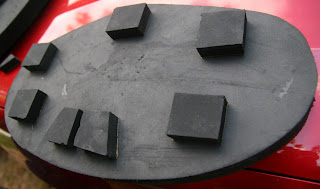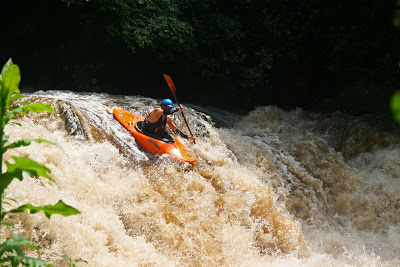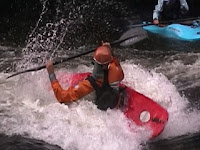
When our “Kid’s Weeks” camps were approaching this year I quickly reminisced on last years adventures and thought about how big of a smile it put on my face at the end of the week. First, for the great times I had just experienced, and second, handing the children back over to their parents with a new perspective on life. Many of the newbie instructors received advice from me on what to expect, “It is a constant test in patience and humility, as well as a contest for the kids to find out how many different ways they can ask the same question.”
The premise of our “Youth Kayak Adventures” is to build confidence in a special week of “camp” packed with fun, adventure and kayaking all in a supportive environment. This could not be closer to the truth. Our core instruction programs from novice to advanced focus on skill progressions to become better paddlers, whereas “Kids Weeks” focus primarily on group awareness, support and fun. In my typical clinic format I have a tendency to focus on skills and drilling, where everything is focused and goal oriented. This is a common quality of an adult world. Kid’s just wanna have fun, and if they learn something… cool! I do find however if you brief children on daily expectations, what to anticipate, group awareness and group safety, they will have more fun and they will learn their lessons from the river as they go along. This aspect of “Kids Weeks” has taught me the virtue of play in my daily instruction.

The coolest thing about working with children is their raw emotion and their ability to express their feelings, as opposed to adults who for the most part are largely guarded with their emotions on the water. This requires us as instructors to do a lot more talking to either feel out, encourage or reinforce particular skills or emotions on the water for adults. Simply stated, with children you just do not have that. I am not saying that it does not happen, but in large part the majority of children and teens wear what they are feeling on their sleeves. They will let you know when they are not happy, if they are bored, hungry, scared, ecstatic or tired. They do not need the constant reinforcement of what they are doing right or wrong (on the water). To them, if they are smiling, they are doing something right. And if they are not, something is wrong. Our biggest job during these weeks is to facilitate a positive experience and reinforce this positive experience with some hard skills and soft skills that they have unknowingly learned.
Initially I had a hard time coping with all of these ideas, especially when my kids decided that they would rather swim in the rapids as opposed to ferry, peel out or eddy out. Afterall, if this was any other clinic these basic skills would be the primary focus of the first day for a novice. It personally frustrated me that they would be so immature as to jump in the river and play instead of learn. Then it hit me like a brick wall. The children were actually learning to become comfortable with their new environment and were learning the most fundamental self-rescue skill. Maybe if I jumped in the river a little more often I would not be so petrified to swim! An opportunity had suddenly presented itself and a teachable moment arose from the ashes like a phoenix. Before too long I had the kids doing aggressive swimming techniques and understanding how their “play” is useful as a tool. This is also where I realized I cannot control the entropy of the group dynamic, but instead have to find a way to fit into it.
Let me clarify some things before I lead people to thinking that these weeks are some scary, disorganized blob of children screaming, kicking and biting their way downstream. We focus tremendously on group responsibility and awareness. On the first night of a clinic we spend some time establishing group goals as well as individual goals and how the group will have to work together to achieve them. As Jon Clark so succinctly puts it, “you have to have the respect talk.” In my past experience with team-building we would have called this a “Full Value Contract.” Though I never do anything as structured as a “ Full Value Contract,” It is always good to have a verbal agreement with the group to bring those individual and group goals back into focus.

The most important aspect of our “Kids Week” is simply, play. We as adults get so wrapped up in our “real world” that we have forgot the virtue of play and how much it teaches us. When an adult begins to play like a child there is some level of embarassment or immaturity associated with that person. However my personal experiences learning and teaching, the student always learns best when smiling, laughing, or playing. Children typically will listen when they are ready for a lesson, and we as adults can take a lesson from our children.
“Family Fun Day” is where the kids are reunited with their families after five days and the fun and chaos takes a float down the Nantahala River. This has to be one of the most spectacular sites on the “Nanty” as a group of fifty kids, parents and instructors start moving downstream. This becomes a great time for the kids to showcase their newly acquired kayaking skills to their parents. However, what stands out above all to me is that despite their families being there, they pay more attention to their new friends in their respective groups and make sure that everyone is together and safe. This makes me beam like a proud parent because I feel this is the effect we have as instructors here at NOC. This demonstrates that our instruction with the kids not only showcases kayaking skills, but life skills such as self-reliance, group responsibility and awareness. Not too mention social skills that they utilize to make new friends throughout the week. In conlusion and after all of this being said, “Kids Week” is on the top of my list for best times on and off the river. Head Instructor Rob Barham sums it up pretty well, “Woohoo! Kid’s Week… Chinese Buffet! Woohoo!”
All photos courtesy of Jon Clark
 Stabilizing the Bulkhead
Stabilizing the Bulkhead shaped notches in the foot foam that allows the adjustment rails to fit where they need to be to reach the footplate part of the bulkhead. This usually is about an inch or two away from the side of the boat. You want to foam to be against the sides of the boat. Glue the foam to the footplate with contact cement. For additional lateral stability, add a foam shim to take up the space between the side of the boat and the rail.
shaped notches in the foot foam that allows the adjustment rails to fit where they need to be to reach the footplate part of the bulkhead. This usually is about an inch or two away from the side of the boat. You want to foam to be against the sides of the boat. Glue the foam to the footplate with contact cement. For additional lateral stability, add a foam shim to take up the space between the side of the boat and the rail. The concept is simple and effective. Glue several small blocks of foam onto your bulkhead. Make sure you leave plenty of space between the small foam blocks before gluing them in place. Glue on another large piece of foam shaped like your bulkhead, (don’t steal your buddies bulkhead foam!) so that it looks similar to this one.
The concept is simple and effective. Glue several small blocks of foam onto your bulkhead. Make sure you leave plenty of space between the small foam blocks before gluing them in place. Glue on another large piece of foam shaped like your bulkhead, (don’t steal your buddies bulkhead foam!) so that it looks similar to this one..png)























